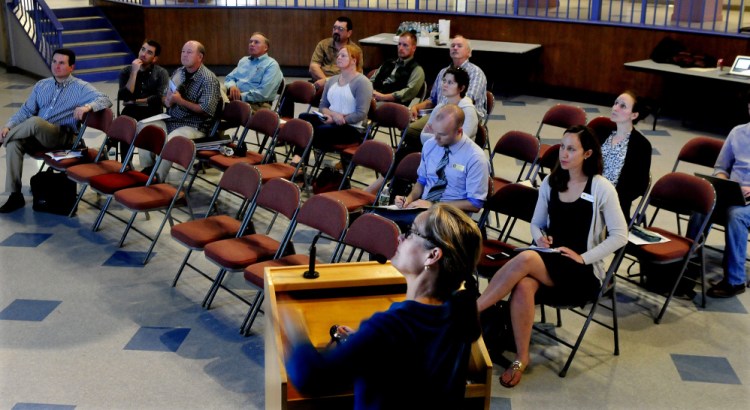WATERVILLE — In recent months, a number of renewable energy projects in the region have either been announced, begun construction or outright flipped the switch and are operational. Many of these projects, whether the proposed 20-megawatt solar array at the capped Waterville landfill or the up-and-running 26,000-panel array in Madison, are larger in scale and benefit large numbers of people.
But renewable energy — whether it be solar, biomass or biofuels — are available on a much smaller scale; and for business owners and farmers in the rural parts of Maine, there’s plenty of incentive to explore these options.
Speaking at a Central Maine Growth Council workshop for renewable energies Wednesday at Colby College, Jennifer Brennan, energy projects manager at the Greater Portland Council of Governments, said her agency can help small businesses in rural areas and agricultural producers procure competitive grants and loans through the U.S. Department of Agriculture Rural Development Program.
The Renewable Energy for America Program, commonly referred to as REAP, provides guaranteed loans and grants for renewable energy systems or to make energy efficiency improvements for small businesses and producers. Brennan said the federal government funds this program for a variety of reasons, including the fact it reduces the demand for energy, increases energy independence and reduces energy costs, which, in turn, allows those using the program to invest more in their operations.
Brennan said REAP is not a program for residential projects, and generally it applies only in communities with a population of 50,000 or less.
Eligible REAP projects fall into the category of energy efficiency, such as improving lighting or heating, and renewable energy such as solar and wind energies, she said, and applying for these programs is a relatively noncumbersome process. Funds can be used for equipment, retrofitting services, professional service fees, and permit and licensing fees.
Last year, there were 44 REAP applications in the state, 27 of which were funded across 10 counties, she said.
“There are substantial funds available,” Brennan said.
Sue Jones, president of Community Energy Partners LLC, a Freeport-based renewable energy and efficiency consulting company, said the number of REAP-eligible biomass projects has expanded in recent years. Biomass is a type of energy produced by burning wood or other organic material, such as crop residue, vegetative and animal waste byproducts. She said REAP funds equipment in a handful of biomass categories. The first is equipment that runs on wood and pellets and hay, such as boilers or combined heat and power devices that run on biomass. The second is equipment that converts biomass into new products, such as chips and cordwood. The third, which Jones said was not prevalent in Maine, is for liquid biofuels. Another, which falls into the category of energy efficiency rather than renewable energy projects, is retrofitting or replacing existing biomass systems.
Jones said the vast majority of REAP money goes toward solar projects, in part because they tend to cost less and score well during the application process. They also are not as complex as other technologies.
“If you’re new to REAP, you may want to think about solar,” she said.
Jones said there are multiple funding sources to incentivize solar projects, such as a 30 percent federal tax credit that runs until the end of 2019. Beginning in 2020, that incentive will start to decrease until it disappears. She said the credit theoretically could return depending on action and change in the Legislature, but the credit provides a valuable tax advantage. She said there are multiple opportunities to get that money. Smaller projects, which cost $80,000 or less, can be applied for up to five times.
“So hang in there, especially with solar, because you never know who you’re competing with,” she said.
Jones also said there are other solar project incentives, such as net energy billing, which allows more people to co-own projects and share the risks and rewards. It is a metering and billing practice in which a customer is billed on the basis of net energy over a billing period, and monthly excess is credited back at the local retail rate.
Colin Ellis — 861-9253
cellis@centralmaine.com
Twitter: @colinoellis
Send questions/comments to the editors.




Success. Please wait for the page to reload. If the page does not reload within 5 seconds, please refresh the page.
Enter your email and password to access comments.
Hi, to comment on stories you must . This profile is in addition to your subscription and website login.
Already have a commenting profile? .
Invalid username/password.
Please check your email to confirm and complete your registration.
Only subscribers are eligible to post comments. Please subscribe or login first for digital access. Here’s why.
Use the form below to reset your password. When you've submitted your account email, we will send an email with a reset code.